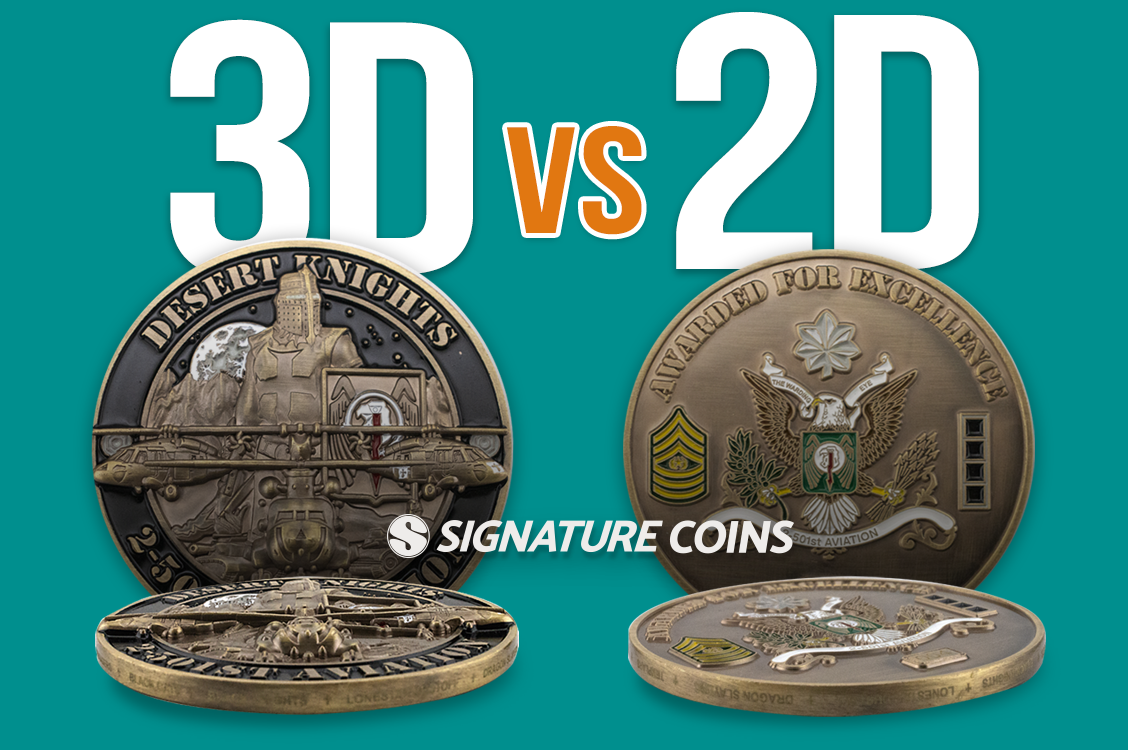
From Concept to Coin: 3D vs. 2D Challenge Coins
By: Lawrence Chan
There’s easily a vault’s worth of questions you could ask about designing a unique set of challenge coins, but one common line of questioning we receive at Signature Coins is the difference between 3D and 2D coins. With this post, I hope to answer the most common questions you might have about the topic and help you decide which is best for your design.
What is the difference between a 3D and 2D challenge coin?
When referring to a coin as 3D or 2D we refer to the number of raised or recessed “levels” on a coin’s metal surface. A 2D coin has exactly two levels on the surface. A raised level coming out of the coin’s surface and a recessed level slightly deeper into a coin. A 2D coin has a sharp and clear contrast between the two levels on its surface, much like a series of plateaus on a flat plain. Meanwhile, a 3D coin takes full advantage of an almost infinite number of levels, allowing us to slope and round edges between levels of raised and recessed areas on a coin. A 3D coin would allow you to create perfectly round surfaces and capture the feeling of different textures on a coin’s surface.
An easy way to tell the difference between the two is to set a coin flat on top of a table. If the coin sits flat without wobbling, then it’s probably a 2D coin. If a coin wobbles slightly on the surface of its design, then it’s most likely a 3D coin. Additionally, you can easily stack the same set of 2D coins on top of one another flat but have a hard time doing so with a set of 3D coins.
Both options have physical characteristics that change the look, feel, and weight of your coin. Neither 2D or 3D options are necessarily better than the other and both options are effective for creating different designs. Ultimately, deciding which is best for you is an important part of the design process.
Five Factors to Consider When Deciding Whether to Order 2D Coins
You should consider the following factors when deciding on whether to order a set of 2D challenge coins.
- One of the biggest advantages to ordering a set of 2D coins is it’s virtually always cheaper and faster. With only two levels, it’s easier and less time-consuming to create, proof, produce, and then deliver a 2D coin.
- The sharp contrast between the raised and recessed surfaces of a 2D coin make it easy to color different sections of the recessed surfaces, which can be important for rank markers, flag colors, or other color elements to be incorporated into a design.
- A 2D coin can be ordered in smaller and thinner coin sizes without losing visual details on the original design or image. It can become difficult to maintain the details on a 3D coin if the coin is smaller than an inch and a half.
- If incorporating a glossy or highly polished design, the the sharp decline between raised and recessed surfaces of a 2D coin is ideal for maintaining a clean and shiny look without gleaming too bright to notice details at a glance.
- A 2D design is better for naturally capturing the exact appearance of a person’s face or expression on the surface of a coin.
Five Factors to Consider When Deciding Whether to Order 3D Coins
You should consider the following factors when deciding on whether to order a set of 3D challenge coins.
- The extra time needed to order a set of full 3D coins is worth the extra time and cost due to the ability to capture and integrate the full shape and details of a coin design. A 3D coin has layers, shapes, and other physical design elements impossible to capture on the surface of a 2D coin.
- A 3D coin is usually better for capturing the precise size, shape, and feel of the edges and surfaces of a unique design not fitting the mold of a typical circular coin.
- While it is more difficult to incorporate color to a 3D coin, it’s not impossible to add color to a 3D coin. Using special transparent paints and careful design choices, we can fill in your design with different layers of colors that “pop” into stunning relief on the physical product.
- The rounded curves and shapes of 3D coins are ideal for antiquing the surface of the coin and allowing the natural shape to capture shadows and shades looking fuller and more animated.
- Images and designs with details such as mountains, buildings, and illustrations can take full advantage of the a 3D coin’s full spectrum of textures, allowing a design to look much more photo-realistic.
The Best of Both Worlds
Choosing between a 2D or 3D coin might place you in a dilemma if your great design only comes to life on a 3D coin, but you want to incorporate the official colors of a unit or organization. However, the two options aren’t mutually exclusive and it’s possible to get the best of both worlds by ordering a coin 2D on one side and 3D on the other. This compromise is cheaper than ordering a coin with 3D designs on both sides, allows you to take advantage of the design depth of a 3D coin, and incorporates the full spectrum of color options of 2D coins. Another idea is picking areas of a design like the edges, a unique emblem, or other element to have 3D details, but keep sections of the coin within two layers to maintain those sharp easy-to-color recesses.